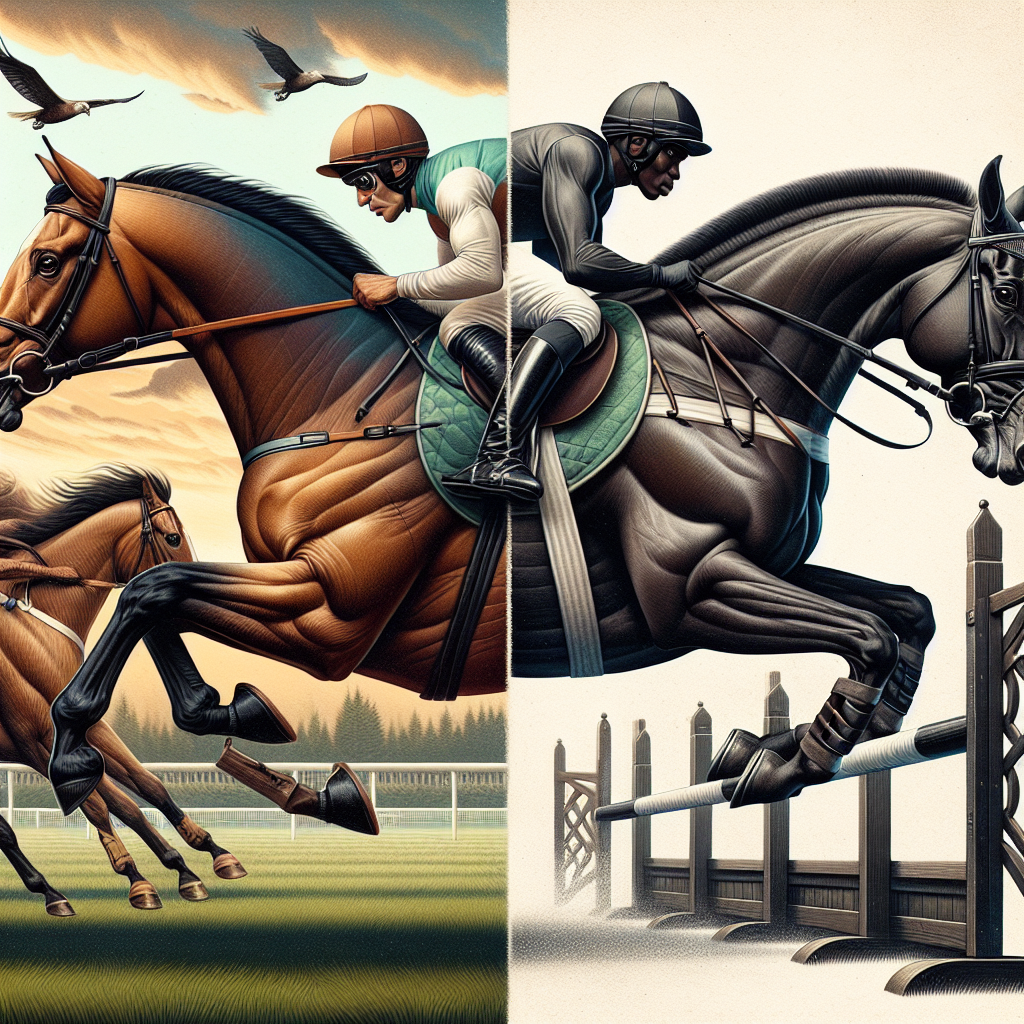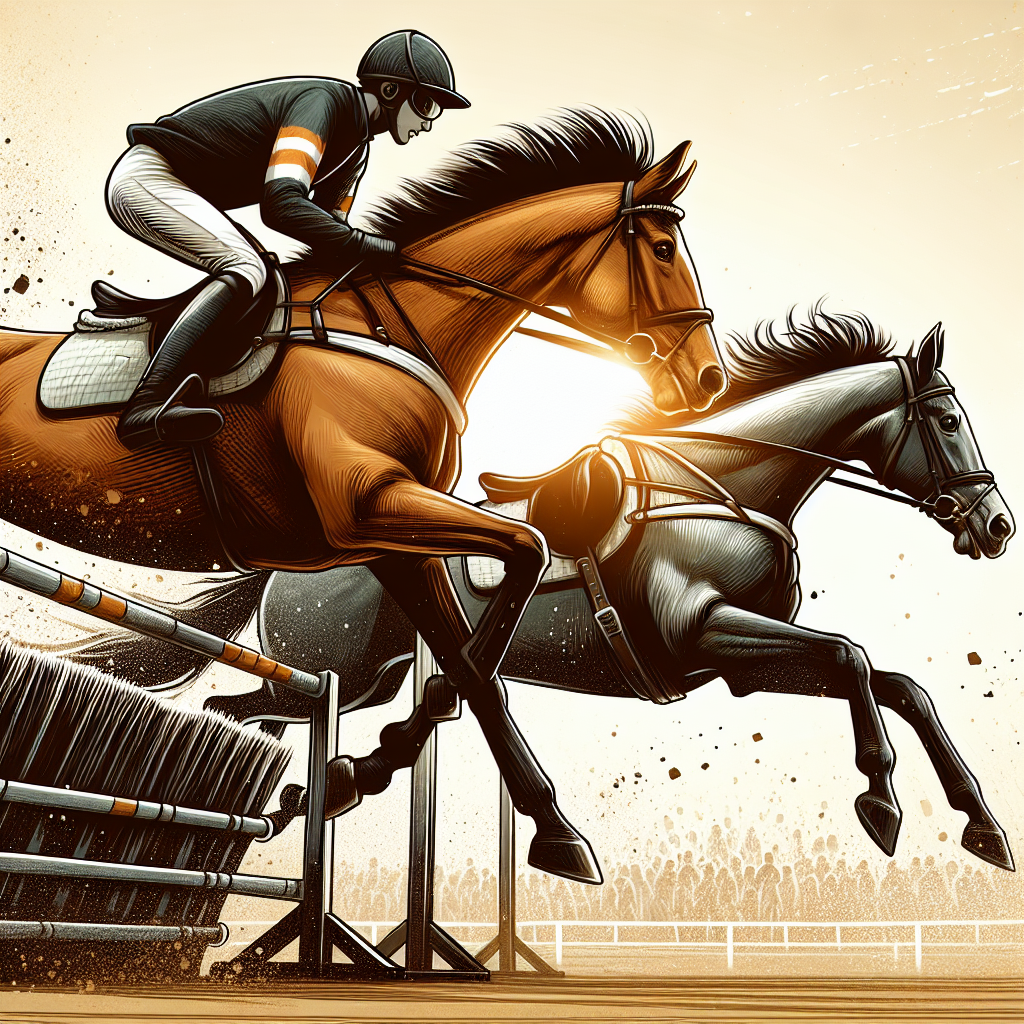What Is The Difference Between “flat Racing” And “jump Racing” In Horse Racing?
The intricate world of horse racing beckons with its thrilling dimensions and the adrenaline rush, and two of its most compelling aspects emerge as flat racing and jump racing. This incisive article clarifies the distinction between these two racing types, providing concise, comprehensive information on their major characteristics, their rules, and the training methods required for each. From the physicality of the horses to the skills of the jockeys, you will understand the elements that define and differentiate these two exciting paradigms, thus enriching your appreciation for the sport.

Understanding Horse Racing
Horse racing is an age-old sport that combines agility, speed, and strength. Not only is it a thrilling spectacle that entertains millions worldwide, but it also has deep cultural and historical significance.
Defining horse racing
Horse racing is a competitive sport where jockeys, each riding a horse, compete against each other on a specified track. The main objective is straightforward—to cross the finish line first. The distance of the tracks, or the type of obstacle, if any, largely varies, contributing to the two main types of horse racing: flat racing and jump racing.
The significance of horse racing in different cultures
Horse racing holds cultural importance in many societies worldwide. Whether it be the Arabian tribes where horses symbolized power and social status, or the British royal circles, where it was an essential part of court life. The sport’s significance is not exclusive to entertainment; it has been a fundamental aspect of various cultural practices, ceremonies, and even mythologies.
The rules of racing
The regulations vary globally, but general rules maintain that horses must be thoroughbred or a specific breed, and jockeys must comply with designated weight limits. Horses also have to pass specific health checks, and the use of drugs or artificial enhancement methods is strictly prohibited. Breakage of these rules can result in disqualification or suspension.
Introduction to Flat Racing
Flat racing is one of the most popular forms of horse racing and has a rich history woven into its fabric.
Defining flat racing
Flat racing, as the name suggests, takes place on a level track without any obstacles. The length of the track often varies, usually ranging from half a mile to two miles. It’s primarily a test of speed and strategy, with the fastest horse coming out on top.
The history of flat racing
Originating from the fields of England in the early 17th century, flat racing quickly grew in popularity and became an enjoyable pastime for both the elite and the common folk. With time, it spread to other parts of the world, such as the United States and Australia, establishing itself as an international sport.
Significant flat races around the world
The most prominent flat races include The Kentucky Derby in the United States, The Derby in England, and The Melbourne Cup in Australia. These events attract the best horses and jockeys from around the globe and are known for their rich prize money and prestige.
Aspects of Flat Racing
The track in flat racing
Flat racing tracks are typically oval or rectangular and can be covered with traditional turf, synthetic surfaces, or dirt. The surface type can affect the horse’s speed and the jockey’s strategy.
The horses used in flat racing
Thoroughbreds are the most common breed used in flat racing due to their exceptional speed and endurance. Their lean body shape and athletic build make them perfect candidates for flat racing events.
The jockeys in flat racing
In flat racing, jockeys must have a deep understanding of their horse’s abilities and employ effective strategies to pace the race. They also need to be physically fit and lightweight to not hinder the horse’s performance.

Understanding Jump Racing
Jump racing brings an added element of excitement and danger to the otherwise straightforward flat races.
Defining jump racing
Also known as steeplechasing or hurdle racing, jump racing requires horses to jump over obstacles while racing towards the finish line. This form of racing not only tests a horse’s speed but also its agility and jumping ability.
The history of jump racing
Jump racing traces its roots back to Ireland in the 18th century. It gradually gained popularity and spread to England and other countries, eventually becoming a beloved and respected form of horse racing.
Significant jump races around the world
Internationally recognized jump races include the Grand National in England and the Nakayama Grand Jump in Japan, where horses face challenging conditions while showcasing their versatility and bravery.
Aspects of Jump Racing
The track in jump racing
The jump racing tracks, also known as ‘National Hunt’ tracks in the UK, are typically larger than flat racing tracks and come equipped with a range of obstacles like fences, ditches, and hurdles.
The horses used in jump racing
While any breed can participate, horses with a sturdy build and strong jumping abilities are usually chosen. They need to be more robust and anatomically suited to handle the physical demands of the jumps.
The jockeys in jump racing
Jump racing jockeys need a different skill set. Alongside excellent riding skills, they require a good understanding of their horse’s jumping abilities and strategize when to push the horse for speed or save energy for the obstacles.
The Main Differences between Flat Racing and Jump Racing
It’s often in the details where flat racing differs significantly from jump racing.
Differences in the track
While both races take place on an elongated track, the critical difference lies in the presence or absence of obstacles. Flat racing is conducted on a level field, while jump racing requires horses to clear hurdles or obstacles.
Differences in the horses
Differences in posture, build, and temperament are distinctive determining factors for a horse’s suitability for flat or jump racing. Speedy and lean thoroughbreds are ideal for flat racing, whereas sturdy horses are preferred for their ability to handle jump racing’s physicality.
Differences in the jockeys
The jockey’s role varies significantly in each racing type, as strategies for each form are different. In flat racing, pacing the horse and saving enough energy for the final dash is critical. In contrast, jump racing requires the jockey to manage the horse’s energy for both sprinting and jumping.
The Similarities between Flat Racing and Jump Racing
Despite the differences, there are common factors shared between flat and jump racing.
Similarities in the rules
Though they differ in track structure and tactic, the two racing forms share an almost identical rule book, with restrictions on horses’ breed, jockeys’ weight, and prohibitions against the use of performance-enhancing substances in horses.
Similarities in the horses
Both types of races require horses to possess remarkable speed, endurance, and agility. A good rapport between the jockey and horse is crucial in both types of races.
Similarities in the level of competition
The intensity of competition is high in both forms of racing, with internationally acclaimed events in each category attracting some of the world’s finest horses and jockeys.
Training for Flat Racing versus Jump Racing
Training serves as a crucial element for both types of racing, despite differing techniques utilized to prepare a horse.
Training methods for flat racing
Training for Flat racing focuses on enhancing speed and stamina. Horses are pushed to increase their velocity while also working on maintaining the pace throughout the race.
Training methods for jump racing
Jump racing training includes strengthening exercises and jump practices in addition to speed and endurance workouts. The horses are also trained to land correctly after a jump to avoid injuries.
The importance of correct training for both racing types
The right training ensures the horse is prepped and ready for the race, minimizing risks and maximizing performance. It makes them physically fit, mentally alert, and less prone to injuries.
The Risks and Safety Measures in Flat Racing and Jump Racing
Despite all the thrill and entertainment they bring, horse races are not without dangers and risks.
Dangerous aspects in flat racing
In flat racing, the threats come from speed. The horses run fast, and a misstep can result in severe injuries or even fatalities. The lack of visibility due to dust, the risk of collisions during mass starts, are all factors adding to the danger element.
Dangerous aspects in jump racing
In jump racing, the risks are multiplied due to the added element of jumping. Falls from hurdles can be severe, leading to serious injuries or fatalities both for horse and jockey.
Safety measures required in both racing types
Despite the inherent risks, safety protocols are in place, including track maintenance, proper warmup of horses, and adequate protective gear for the jockeys. Regular health checks for the horses are mandatory, ensuring they are fit to race.
The Influence of Flat Racing and Jump Racing on Horse Breeding
It’s known that the type of racing influences the breeding and selection of horses.
The ideal traits for flat racing horses
For flat racing, breeders look for horses with elongated bodies for maximized stride length, a good balance of speed and endurance, and lean, muscular physiques.
The ideal traits for jump racing horses
In contrast, jump racing breeders look for horses with stronger hindquarters for a more powerful jump, an assertive disposition to negotiate obstacles, and a sturdy body to withstand the physical strain.
The impact on breeding
The racing type leaves a significant imprint on breeding programs. Sires with suitable traits for either racing are sought, highlighting horse racing’s dynamic influence on equine genetics and breeding operations.
Horse racing, despite its varied forms, brings a unique charm like no other sport. Whether it’s the speed-fueled flat races or the jump-filled thrill of jump races, the sport continues to captivate audiences worldwide with its balance of athleticism, strategy, and entertainment. It’s a testament to both the strength of the athletes – both human and equine – and the sport’s continued evolution and growth.

